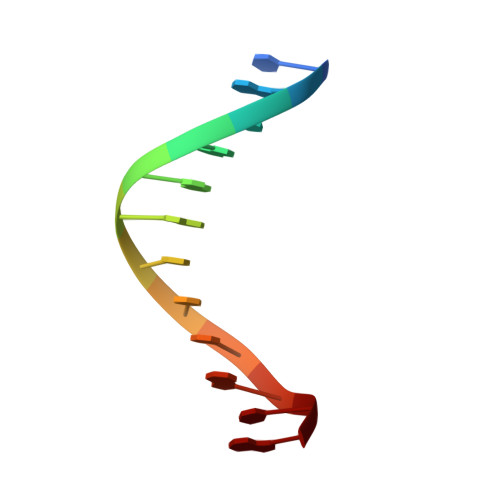A thermodynamic and structural analysis of DNA minor-groove complex formation.
Mazur, S., Tanious, F.A., Ding, D., Kumar, A., Boykin, D.W., Simpson, I.J., Neidle, S., Wilson, W.D.(2000) J Mol Biol 300: 321-337
- PubMed: 10873468
- DOI: https://doi.org/10.1006/jmbi.2000.3869
- Primary Citation of Related Structures:
1EEL - PubMed Abstract:
As part of an effort to develop a better understanding of the structural and thermodynamic principles of DNA minor groove recognition, we have investigated complexes of three diphenylfuran dications with the d(CGCGAATTCGCG)(2) duplex. The parent compound, furamidine (DB75), has two amidine substituents while DB244 has cyclopentyl amidine substituents and DB226 has 3-pentyl amidines. The structure for the DB244-DNA complex is reported here and is compared to the structure of the DB75 complex. Crystals were not obtained with DB226 but information from the DB75 and DB244 structures as well as previous NMR results on DB226 indicate that all three compounds bind in the minor groove at the AATT site of the duplex. DB244 and DB75 penetrate to the floor of the groove and form hydrogen bonds with T8 on one strand and T20 on the opposite strand while DB226 forms a complex with fewer interactions. Binding studies by surface plasmon resonance (SPR) yield -delta G degrees values in the order DB244>DB75>DB226 that are relatively constant with temperature. The equilibrium binding constants for DB244 are 10-20 times greater than that for DB226. Isothermal titration calorimetric (ITC) experiments indicate that, in contrast to delta G degrees, delta H degrees varies considerably with temperature to yield large negative delta Cp degrees values. The thermodynamic results, analyzed in terms of structures of the DNA complexes, provide an explanation of why DB244 binds more strongly to DNA than DB75, while DB266 binds more weakly. All three compounds have a major contribution to binding from hydrophobic interactions but the hydrophobic term is most favorable for DB244. DB244 also has strong contributions from molecular interactions in its DNA complex and all of these factors combine to give it the largest-delta G degrees for binding. Although the factors that influence the energetics of minor groove interactions are varied and complex, results from the literature coupled with those on the furan derivatives indicate that there are some common characteristics for minor groove recognition by unfused heterocyclic cations that can be used in molecular design.
Organizational Affiliation:
Department of Chemistry, Georgia State University, Atlanta, GA 30303, USA.















